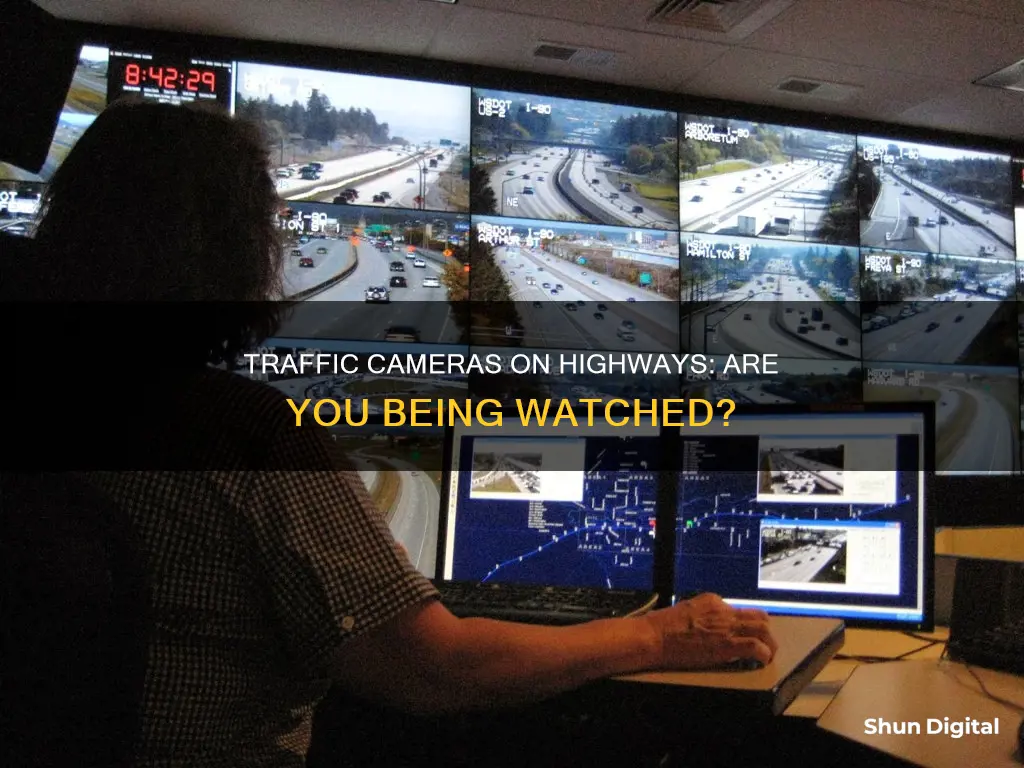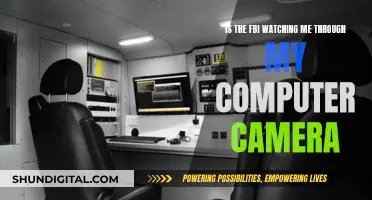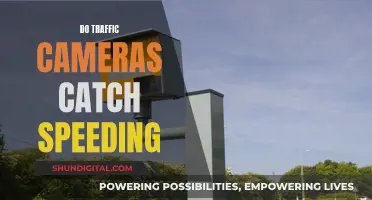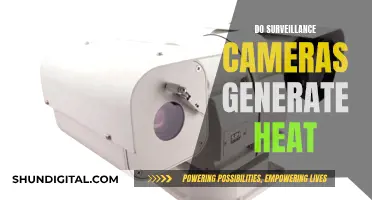
Traffic cameras are a common feature on highways and roads across the world. These cameras are used to monitor traffic, manage congestion, and improve road safety. They can be mounted on masts or gantries, or installed in enforcement vehicles, and are used to detect a range of motoring offences, including speeding, red-light running, and toll violations. While some people argue that these cameras invade privacy and are used for revenue collection, studies have shown that they can effectively reduce accidents and injuries on roads.
| Characteristics | Values |
|---|---|
| Purpose | Detecting motoring offenses, including speeding, red-light running, toll booth avoidance, and bus lane misuse |
| Installation | Mounted on 12m high masts on the grass verge, overhead gantries, enforcement vehicles, or installed in garbage bins |
| Users | Regional and National Traffic Operations Centre operators, media organizations, web hosts, police |
| Benefits | Improved road safety, reduced congestion, easier commute, and safer roadways |
| Concerns | Loss of privacy, mass surveillance, revenue generation, lack of human interaction during traffic stops |
What You'll Learn

Traffic cameras help with congestion and incident management
Traffic cameras are an essential tool for managing congestion and incidents on highways and roads. They provide a bird's-eye view of the situation, helping operators make informed decisions and improve traffic flow. For instance, the Nevada Department of Transportation offers live traffic cameras as part of its Intelligent Transportation Systems, which also include freeway digital message signs, Highway Advisory Radio, and freeway ramp meters. These systems work together to improve mobility, safety, and management on Nevada's state roads.
Traffic cameras are also used in England, where nearly 4000 cameras assist with managing traffic on the motorway and trunk road network. These cameras are typically mounted on high masts or overhead gantries, providing a comprehensive view of the roads. The images captured by these cameras can be accessed by the public through the Traffic England website, helping drivers make informed decisions about their travel plans.
The benefits of traffic cameras are not limited to just one country or region. For example, Axis, a company providing intelligent video-based solutions for traffic management, has helped reduce incident response times in Caen, France, by 50%. Their advanced traffic management system, which includes intelligent traffic cameras and sensors, enables authorities to respond to situations promptly, plan roadwork maintenance, and optimize long-term mobility.
The effectiveness of traffic cameras in reducing congestion and managing incidents is well-documented. A worldwide review found that speed cameras led to a significant reduction in fatal and serious injury crashes, with similar results observed in the UK. Additionally, traffic cameras can provide early warnings of incidents or advance notice of cleared incidents, helping drivers make informed decisions about their routes and travel times.
In conclusion, traffic cameras play a crucial role in congestion and incident management on highways and roads. They provide valuable real-time data and insights that help operators make informed decisions. By improving traffic flow and reducing response times, traffic cameras enhance the safety and efficiency of our transportation systems.
Are Camera Batteries Safe for Flying?
You may want to see also

They are also used for speed limit enforcement
Traffic cameras are often used to monitor congestion and incidents on highways and assist with traffic management. They are also used for speed limit enforcement.
Speed safety cameras (SSCs) are one of the 28 Federal Highway Administration’s Proven Safety Countermeasures. SSCs are automated solutions that collect evidence of speeding violations without the need for officers to make personal contact with drivers. They are proven to be effective in reducing crashes and improving safety on roads. For instance, a 2017 LSE study found that adding another 1,000 cameras to British roads could save up to 190 lives annually, reduce up to 1,130 collisions, and mitigate 330 serious injuries.
SSCs use Doppler radar, LIDAR, stereo vision, or automatic number-plate recognition technology to monitor compliance with speed limits. They can be fixed or mobile, and are usually mounted on high masts on the grass verge or on overhead gantries. Fixed camera systems may be mounted on poles or attached to gantries, overpasses, or bridges. Mobile speed cameras may be hand-held, tripod-mounted, or vehicle-mounted.
While SSCs are proven to be effective, they are not without controversy. Some groups, such as the American Civil Liberties Union, claim that the use of speed traps as a revenue source undermines the legitimacy of safety efforts. Additionally, there are concerns about the loss of privacy and the potential for governments to establish mass surveillance of vehicle movements.
Finding the Camera Raw Dialog Box
You may want to see also

Red light cameras are a type of traffic camera
Traffic cameras are used to monitor traffic and road conditions. They are often used to help drivers make informed travel decisions, such as whether to avoid an area due to congestion or an incident. They are also used to improve the safety and management of roads. In England, for example, there are almost 4000 traffic cameras on the motorway and trunk road network.
Red light cameras are automated traffic enforcement cameras (ATECs) that issue penalties and violations. They are different from other types of cameras, such as traffic sensor cameras, which are used to monitor traffic flow and determine traffic light timing, and speed cameras, which monitor and enforce speed limits.
Red light cameras are often controversial due to their automated ticketing system and the fact that they do not issue moving violations or criminal charges. From a legal standpoint, violations captured by red light cameras are administrative violations, similar to parking tickets. This means that drivers do not have the right to face their accuser in court. However, ignoring a red light ticket can have consequences, such as damage to one's credit score and increased auto insurance rates.
Overall, red light cameras are a specific type of traffic camera designed to enforce traffic laws at intersections and hold drivers accountable for running red lights.
Cameras of 1912: A Historical Snapshot
You may want to see also

Traffic cameras can be fixed or mobile
Traffic cameras are used to monitor traffic on highways and roads. They are often mounted on high masts or overhead gantries, and are used to help manage traffic and improve safety. There are two main types of traffic cameras: fixed and mobile.
Fixed speed cameras are typically used in high-risk locations such as tunnels or areas with a history of severe crashes. They are installed at sites that meet specific criteria, including crash rates and travelling speeds. These cameras are highly visible and are accompanied by warning signs to deter drivers from speeding. Fixed cameras use electronic sensors embedded in the road surface to detect the speed of vehicles. If a vehicle is speeding, a digital image is recorded, including the vehicle's type, number plate, location, direction of travel, and speed.
On the other hand, mobile speed cameras are not permanently mounted and can be located on tripods or inside vehicles. They are moved from location to location, making them more challenging to spot. Mobile cameras use a special type of radar that is difficult for radar detectors to detect, such as low-powered K-band and MRCD. They are effective due to their unpredictability, creating a general deterrence against speeding and reducing crashes across the entire road network.
Both fixed and mobile cameras play a crucial role in traffic management and road safety. They help authorities make informed decisions, improve traffic flow, and reduce the risk of accidents. Additionally, traffic cameras can be used to detect various motoring offences, including speeding, running red lights, and unauthorised use of bus lanes. The presence of these cameras can act as a deterrent and encourage drivers to follow traffic rules, ultimately contributing to safer roadways.
It is worth noting that the use of traffic cameras varies across different jurisdictions, and there are ongoing debates about their effectiveness, privacy implications, and potential for government overreach. However, studies have shown that speed cameras, in particular, can lead to a significant reduction in crashes, injuries, and fatalities.
Charging Your ADT Camera Battery: A Step-by-Step Guide
You may want to see also

They are often mounted on masts or gantries
Traffic cameras are often used to assist with the management of traffic on motorways and road networks. In England, for instance, there are almost 4000 traffic cameras owned by National Highways, which are usually mounted on 12-metre-high masts on the grass verge or on overhead gantries. These cameras are typically inconspicuous, as they are not painted with high-visibility paint and are not used for speed enforcement. Instead, they are primarily used by Regional and National Traffic Operations Centre operators to monitor and manage congestion and incidents. The operators can move and zoom the cameras to get a bird's-eye view of the situation, helping them decide on the necessary support.
Mounting traffic cameras on masts or gantries provides a vantage point for capturing images or videos of the traffic situation. The height of the masts or gantries ensures that the cameras have a clear view of the road, allowing them to capture a wide area and monitor multiple lanes of traffic. This elevated position also helps to avoid any obstructions that may be present at ground level, such as road signs, trees, or other vehicles.
The use of masts or gantries for traffic cameras offers several advantages. Firstly, it provides a stable and secure platform for the cameras, reducing the risk of vibration or movement that could affect the image quality. Secondly, the height of the masts or gantries can be adjusted to ensure the cameras are positioned at the optimal height for capturing clear and detailed images or videos of the traffic. This adjustability allows for flexibility in installation, taking into account factors such as the width of the road, the number of lanes, and the height of surrounding structures.
Additionally, mounting traffic cameras on masts or gantries can help to maximise the coverage area. By strategically placing the masts or gantries at certain intervals or locations, it is possible to capture a continuous feed of the traffic flow, enabling operators to monitor the movement of vehicles and identify any potential issues or congestion. The elevated position also helps to reduce the impact of weather conditions, such as rain or snow, which may obstruct the view of ground-level cameras.
While traffic cameras on masts or gantries are commonly used, there are also other mounting options available. For example, cameras can be fixed to poles or attached to bridges or overpasses. In some cases, more discreet mounting options may be utilised, such as concealing cameras in garbage bins or attaching them to enforcement vehicles. However, the use of masts or gantries remains a popular choice due to their effectiveness in providing a clear and elevated view of the traffic situation.
Crafting Mini Cameras: A Step-by-Step Guide
You may want to see also
Frequently asked questions
Yes, there are traffic cameras on highways. These cameras are used to monitor and manage traffic congestion and incidents.
Traffic cameras are used to detect motoring offenses, including speeding, vehicles going through a red light, toll booth violations, and unauthorized use of bus lanes. They can also be used to monitor traffic conditions, such as congestion or incidents blocking the freeway, to help drivers make informed travel decisions.
Yes, several studies have shown that traffic cameras are effective in reducing accidents and injuries. For example, a review of studies found that speed cameras led to a reduction of "11% to 44%" in fatal and serious injury crashes.
Yes, in some cases, you may be able to access traffic camera footage. For example, in England, anyone can access traffic camera images through the Traffic England website. However, there may be specific procedures and time limits for requesting footage, and the availability of footage may vary depending on the location and purpose of the cameras.
Yes, the use of traffic cameras has raised privacy concerns, particularly with the introduction of advanced technologies like automatic number-plate recognition systems. There are worries about potential government surveillance of vehicle movements and, by association, the tracking of vehicle owners' movements.







